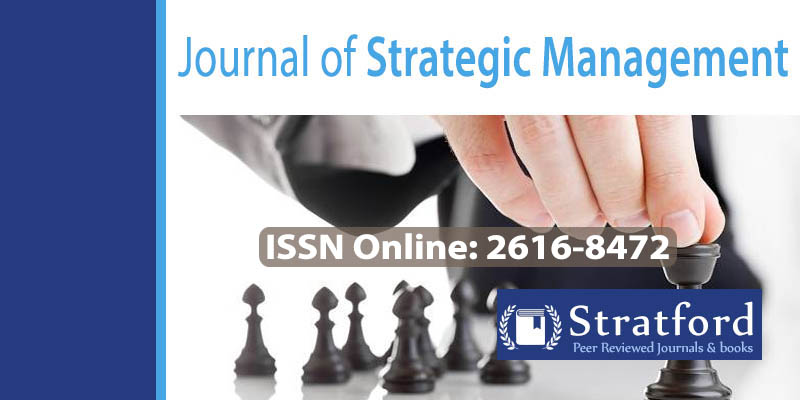Influence of Intellectual Capital on Performance of Large Manufacturing Firms in Kenya
DOI:
https://doi.org/10.53819/81018102t2417Abstract
Intellectual capital has been gaining increased attention in competitive industries due to shortened product life cycles, globalization, rapid technological progress, deregulation and accelerated diffused rates for technology–based products. In addition, only 46 percent of the large manufacturing firms operate a full 8 hours while 47 percent of the businesses run between 6-8 hours a day. Majority of the firms use outdated technology; 83 percent are semi-automated while a measly 11 percent are fully automated. Therefore, this study sought to establish the effect of intellectual capital on performance among large manufacturing firms. This study was guided by positivism philosophy and used a deductive approach. The study adopted a descriptive survey. The population of interest comprised all the 124 large manufacturing firms in Kenya that are members of the Kenya Association of Manufacturer (KAM) as at December 2019. Data was gathered using a questionnaire. The questionnaire targeted CEO, director of human resources and finance. To test the stated hypothesis and correspondingly address this objective, the factor variable, intellectual capital was indicated by 3 sub-constructs, including human capital, structural capital and relational capital while the outcome variable. The study concluded that intellectual capital is a significant predictor of performance among large manufacturing firms in Kenya. By enhancing human capital, large manufacturing firms in the country benefit from a skillful, productive, effective and an efficient workforce which results in performance improvements through more efficient and innovative production processes and products. The study recommends that, for superior performance, large manufacturing firms in the country should invest in their intellectual capital by investing in employee training and development to build skills, expertise and capabilities; and enhancing human resource management systems and programs, improving their reward performance programs in relation to task and promote a supportive firm culture.
Keywords: Human Capital, Structural Capital, Relational Capital, Intellectual Capital, Performance & Large Manufacturing Firms
References
Abualoush, H.S., Masad’eh, R., Bataineh, K. & Alrowwad, A. (2018). The role of knowledge management process and intellectual capital as intermediary variables between knowledge management infrastructure and organizational performance. Interdisciplinary Journal of Information, Knowledge and Management, 13, 279-309
Alonso et al., (2019). Micro Enterprises, Self-Efficacy and knowledge Acquisition: evidence from Greece and Spain pp. 419-438.
Alrowwad, A., Abualoush, H.S. & Masad’eh, R. (2020). Innovation and intellectual capital as intermediary variables among transformational leadership, transactional leadership, and organizational performance. Journal of Management Development, 39(2), 196-222
Bontis, N. & Serenko, A. (2009). Longitudinal Knowledge strategizing in a long-term healthcare organization, International Journal of Technology Management, 47 (1-3), 276 – 97
Edvinsson, L. & Malone, M. (1997). Intellectual Capital: Realising your Company’s True Value by Finding Its Hidden Brainpower, Harper Collins, New York, NY.
Grant, R.M. (1996). Toward a knowledge-based theory of the firm. Strategic Management Journal, 17(52), 109-122
Hsu, I.C. & Sabherwal, R. (2012). Relationship between Intellectual Capital and Knowledge Management: An Empirical Investigation, Decision Sciences, 4(3): 489-524.
Hussainey, K. (2010). Managers and auditors’ perceptions of intellectual capital reporting, Managerial Auditing Journal, 5(9): 844-860.
Inkinen, H., Kianto, A., Vanhala, M. & Ritala, P. (2014). Intellectual capital and performance-empirical findings from Finnish firms, in Carlucci, D., Spencer, J.C. and Schiuma, G. (Eds), Knowledge and Management Models for Sustainable Growth. Proceedings of the 9th International Forum on Knowledge Asset Dynamics, June 11-13, University of Basilicata, Matera, 2918-2933
Jordon, C. M., & Martos, M. S. (2012). Intellectual Capital as Emerging Clusters in Latin America, 462-481.
Kianto, A., Ritala, P., Spender, J.C. & Vanhala, M. (2014). The interaction of intellectual capital assets and knowledge management practices in organizational value creation. Journal of Intellectual Capital, 15(3), 362-375
Kim, T., Yoo, J. & Lee, G. (2011). The honicap scale: measuring intellectual capital in the hotel industry. Service Industries Journal, 3(13), 2243-2272
KIPPRA (2013). Creating an enabling environment for stimulating investment for competitive and sustainable counties. ISBN 978996605801010.
Mahmood, T., & Mubarik, M. S. (2020). Balancing innovation and exploitation in the fourth industrial revolution: Role of intellectual capital and technology absorptive capacity. Technological Forecasting and Social Change, 160, 120248.
McDowell, W. C., Peake, W. O., Coder, L., & Harris, M. L. (2018). Building small firm performance through intellectual capital development: Exploring innovation as the “black box”. Journal of business research, 88, 321-327.
Nahapiet, J. & Ghoshal, S. (1998). Social capital, intellectual capital and the organizational advantage. The Academy of Management Review, 23(2), 242-266
Ordonez de Pablos, P. (2002). “Evidence of Intellectual Capital Measurement from Asia, Europe and Middle East,” Journal of Intellectual Capital, vol. 3, No. 3, pp. 287-302.
Roos, J., Roos, G., Dragonetti, N. C. and Evinsson, L. (1997), Intellectual Capital: Navigating in the New Business Landscape, Macmillan, Basingstoke.
Stewart, T.A. (1997). Intellectual Capital: The New Wealth of Organizations. New York: Doubleday.
Tan et al, (2007). Intellectual Capital and Financial returns of companies, Journal of Intellectual Capital., Vol. No. 1, pp. 76-95.
Ulrich, D. (2009). Intellectual Capital = Competence x Commitment, Sloan Management Review, Cambridge vol. 39, Iss. 2. (Winter 1998):15-26.
Youndt, M.A., Subramaniam, M. & Snell, S.A. (2004). Intellectual capital profiles: an examination of investments and returns. Journal of Management Studies, 41(2), 335-361
Zeglat, D. & Zigan, K. (2013). Intellectual capital and its impact on business performance: Evidence from the Jordanian hotel industry. Tourism and Hospitality Research, 13(2), 83-100


